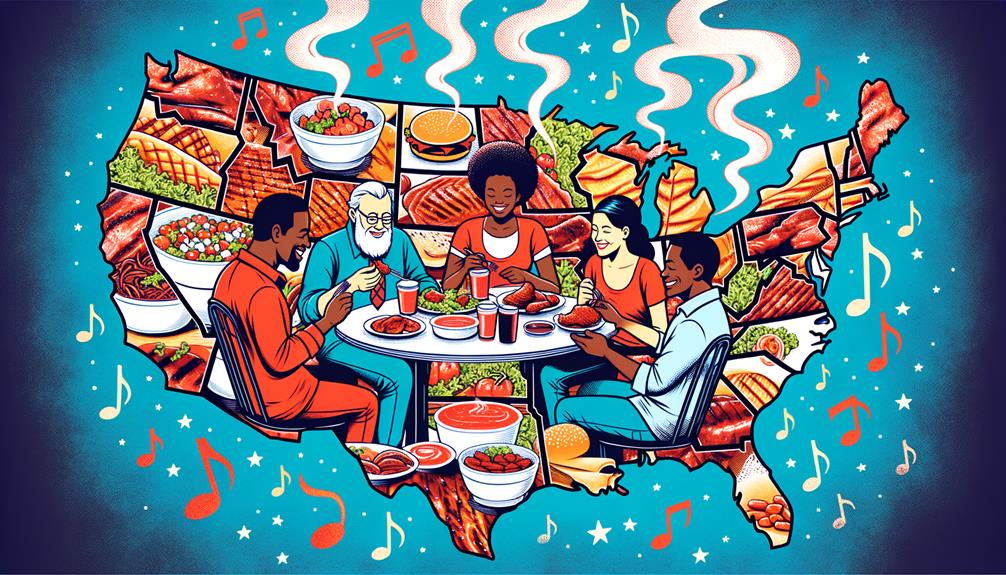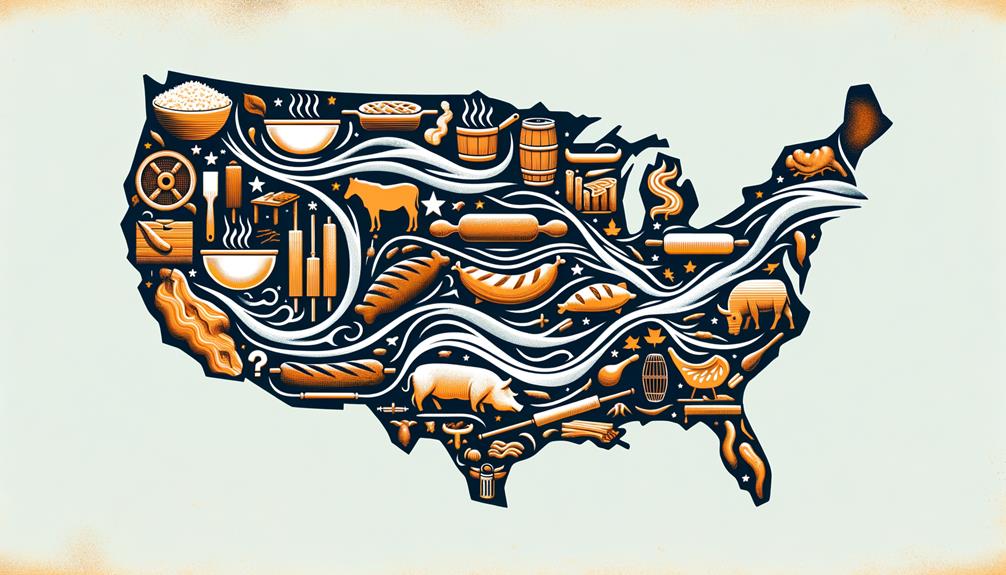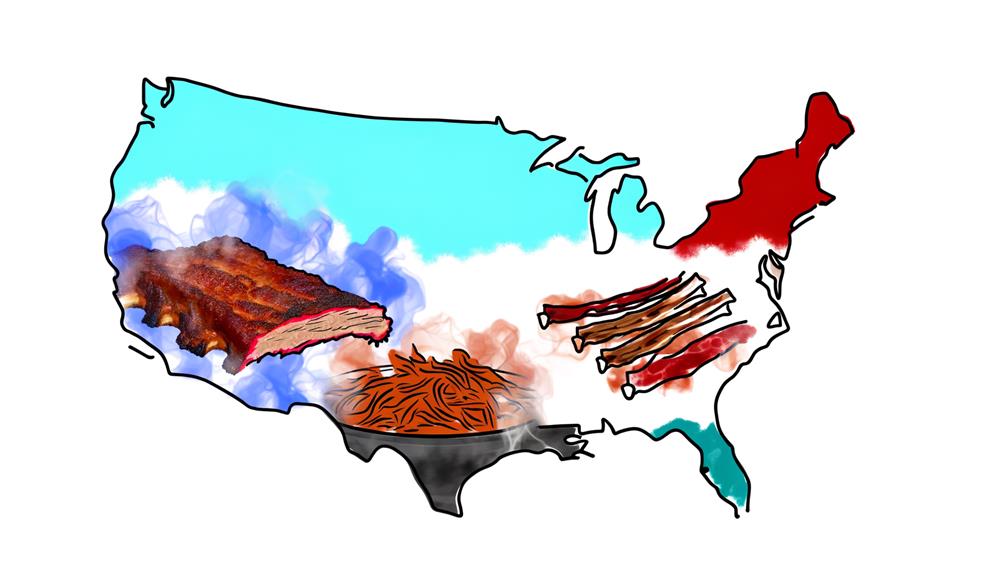As you fire up your time machine and set the dials to the early days of American barbecue, you’ll find the roots of a culinary map as diverse as the landscape itself.
You’re about to discover why you can’t sling a rib without hitting a different barbecue style in the United States. Each region’s unique blend of history, geography, and culture has seared its signature into the meats and techniques you swear by.
Table of Contents
From the vinegar-based tang of a Carolina pulled pork to the spicy dry rub of a Memphis rib, these flavors didn’t just emerge in a vacuum. They’re a testament to the local resources and the communities that crafted them.
So, why exactly does your brisket differ from your neighbor’s two states over? Stay with us as we unravel the smoke rings of time to uncover how regional barbecue dishes became as distinct as the dialects that sing their praise.
Key Takeaways
- Indigenous peoples, German and Czech settlers, and variations in available ingredients have all played a role in the evolution of region-specific barbecue styles.
- Geographic and environmental factors such as terroir, choice of wood, and local climate influence the characteristics and flavors of regional barbecue.
- Barbecue styles reflect cultural identity and signify a community’s story, with each region’s barbecue representing a narrative of people, history, and gastronomic preferences.
- Traditional barbecue dishes are region-specific because of the historical and cultural significance of barbecue, dating back to ancient civilizations, African slaves’ cooking techniques, European settlers’ influences, and the role of barbecue in the development of American regional identities.
Historical Roots of BBQ Styles
Why have regional BBQ styles in the United States developed such distinct characteristics? The answer lies in the historical roots and cultural influences that have shaped each region’s approach to this culinary tradition. The regional barbecue variations we witness today are a testament to the intricate tapestry of American BBQ history.
Diverse cooking methods, introduced by Indigenous peoples and refined over centuries, form the backbone of these regional styles.
In Texas Style barbecue, for instance, the influence of German and Czech settlers is evident in the smokehouse traditions and the emphasis on beef, a reflection of the cattle-ranching culture. Conversely, the barbecue traditions in North Carolina and South Carolina diverged due to variations in available ingredients and the African influence on cooking techniques, particularly the use of vinegar and spices in their sauces.
Each regional style has evolved its unique techniques and preferences, from the rubs and sauces to the choice cuts of meat and customary sides. These adaptations aren’t merely culinary; they represent the historical mosaic of immigration, settlement, and adaptation to local resources.
This scholarly pursuit of understanding regional barbecue underlines the importance of historical context in the evolution of American BBQ.
Geographic Influence on Ingredients
The distinct flavor profiles of regional barbecue dishes are heavily influenced by the geographic availability of specific woods used for smoking, local cuts of meat, and the cultivation of herbs and spices unique to each area. In American barbecue, the terroir—a region’s climate, soil, and landscape—plays a pivotal role in shaping the characteristics of its barbecue.
For instance:
- East Texas barbecue traditionally favors hickory and pecan woods, which impart a sweet, hearty smoke to the regionally preferred beef brisket.
- South Texas pitmasters might opt for mesquite, a wood that burns hot and fast, suitable for the direct-heat grilling of thick cuts like beef fajitas.
A sauce made in one region, such as the mustard-based sauce of South Carolina, reflects the historic preferences and agricultural practices of its inhabitants, including immigrant communities. The distinct barbecue styles across regions can often be traced back to the types of herbs and spices that thrive in the local climate, influencing the rubs and marinades.
Analyzing the geographic influence on ingredients reveals how regional specificities are more than mere tradition; they’re a complex interplay between environment, culture, and history that yields a myriad of distinct barbecue styles. Understanding these nuances enhances mastery over the craft of regional barbecue preparation.
Cultural Significance in Recipes

Delving into the cultural significance of barbecue recipes uncovers a tapestry of historical and social influences that have shaped regional culinary practices. In North America, specifically within the United States, the diversity of barbecue styles and methods reflects a rich heritage that varies from one locale to another.
When you examine American barbecue, you’ll find that the choice of meat, the flavor profiles of the barbecue sauce, and the cooking techniques are not just about taste but also about cultural identity. For instance, pork is pivotal in Southern barbecue traditions due to its historical availability and the cultural practices surrounding pig farming and communal feasts.
Here’s an analytical look at how specific regions have developed their barbecue styles:
| Region | Meat Preference | Sauce & Flavor Profile |
|---|---|---|
| Texas | Beef (Brisket) | Spicy, Tomato-based |
| North Carolina | Pork (Shoulder) | Vinegar-based, Peppery |
| Kansas City | Pork, Beef, Chicken | Sweet, Molasses-rich |
| Memphis | Pork (Ribs) | Tomato and Vinegar Blend |
Each region’s barbecue is a narrative of the people, their history, and their gastronomic preferences. These recipes are not merely methods of cooking; they signify a community’s story, told through the smoke and savor of their cherished barbecue traditions.
Wood and Smoking Techniques
In the realm of barbecue, your choice of wood and its application in smoking techniques play a pivotal role in defining the flavor profile and aroma of the dish, much like how a painter selects a palette to bring a landscape to life.
When you’re cooking meat, particularly meats cooked low and slow like beef ribs in Kansas City or pork ribs in North Carolina, the type of coal or wood used isn’t an arbitrary decision. It’s a method used with intent and tradition in mind.
- Hickory: Imparts a strong, savory flavor favored in many Southern states.
- Mesquite: A potent wood that can overwhelm; used sparingly, it’s ideal for shorter cook times.
- Oak: Provides a medium smoky flavor, versatile and often used in Texas.
- Fruit Woods: Such as apple or cherry, offer a sweeter, more delicate taste for pork and poultry.
The time to cook and the wood and smoking techniques are finely tuned to enhance the natural flavors of the meats. Each region has cultivated these methods over time, creating signature dishes that reflect their cultural and gastronomic heritage.
This scholarly approach to BBQ underscores the complexity and regional pride woven into the fabric of American barbecue culture.
Evolution of Regional BBQ

Exploring how regional BBQ has evolved requires an understanding of the nuanced interplay between local traditions, available resources, and historical migrations that have collectively shaped each distinct barbecue culture.
For instance, North Carolina barbecue, with its focus on pork shoulder and whole hog, reflects the historical abundance of pigs in the region. This barbecue style has been refined over generations, leading to the renowned pulled pork that’s often associated with a vinegar-based BBQ sauce, contrasting with the mustard-based Carolina Gold found further south.
Texas barbecue, on the other hand, demonstrates a different evolution, characterized by a preference for beef due to the state’s rich cattle-ranching heritage. Techniques such as slow smoking over specific woods have become emblematic of Texas barbecue, where dry rubs often take precedence over saucy finishes.
Each regional bbq style embodies a story of its own, where cultural heritage, local ingredients, and historical context have converged to create a rich tapestry of flavors and techniques. The meticulous development of barbecue styles, from rubs to sauces, exemplifies a collective culinary identity, one that aficionados strive to master and preserve.
Through this lens, you’ll discern that regional bbq isn’t a mere coincidence of taste, but a deliberate and scholarly symphony of history, culture, and gastronomy.
Frequently Asked Questions
What Region Is Barbecue From?
You’re wondering about barbecue’s origins; they’re tied to local cultural influences, meat preferences, and historical development. Cooking techniques, sauce varieties, and wood choices vary, reflecting immigrant contributions, seasonal practices, festival celebrations, and social gatherings.
Where Is BBQ Traditionally From?
BBQ’s birthplace is complex, entwined with cultural influences, meat selection, and immigrant contributions. Historical methods, wood choices, and maritime connections shaped its flavor profiles, with sauce origins and cooking techniques reflecting seasonal variations.
Why Is Barbecue Popular in the South?
You’re drawn to Southern barbecue for its rich cultural heritage, where pit masters perfect meat choices and smoking techniques, crafting distinct flavor profiles for social gatherings and outdoor festivities deeply rooted in historic influence.
What Are the 5 Main Styles Regions of BBQ Here in the Us?
You’re diving into a smoky world where sauce variations and meat preferences define regions. Explore the five main BBQ styles, analyzing pitmasters’ secrets and wood choices that shape their historical roots and social gatherings.
Conclusion
In conclusion, you’ve seen how barbecue’s regional specificity is deeply rooted in history, geography, and culture.
For instance, a staggering 95% of Texans prefer beef brisket, reflecting local cattle ranching’s impact on their barbecue style. This preference showcases how regional tastes are shaped by available resources and historical practices.
As you appreciate the smoky flavors of each locale’s barbecue, remember that they’re not just recipes but stories of tradition, innovation, and community identity.










